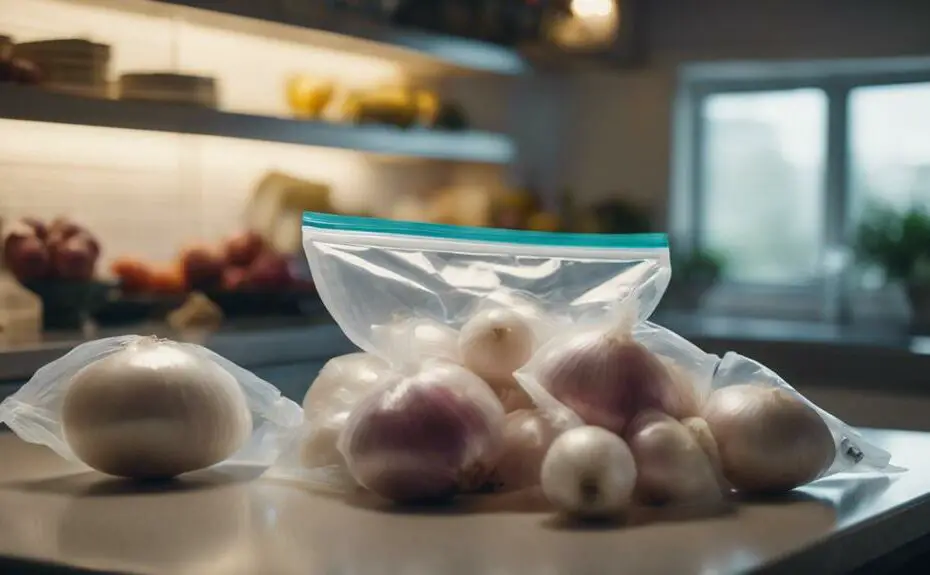Americans waste a staggering 30-40% of their food supply each year. As a passionate cook and food preservation enthusiast, I find this statistic both alarming and motivating. It has inspired me to delve into the art of vacuum sealing and freezing onions, ensuring their long-lasting freshness and reducing waste. Through years of refinement, I have mastered this process, which involves carefully selecting onions, preparing them meticulously, and utilizing a vacuum sealing technique that seals in flavor and freshness. This practice goes beyond just saving onions; it encompasses embracing a sustainable lifestyle. Allow me to take you on this transformative journey, and I guarantee that you will never look at onions the same way again. Get ready to revolutionize your kitchen practices with this game-changing method.
To start, let's discuss the importance of selecting the right onions. When choosing onions for vacuum sealing and freezing, opt for fresh, firm ones without any signs of rot or decay. It's also beneficial to choose onions with a thick, papery skin, as this helps to protect them during the freezing process.
Once you have selected your onions, it's time to prepare them for freezing. Begin by peeling and chopping the onions to your desired size. You can dice them, slice them, or even leave them in larger chunks, depending on how you plan to use them later. Remember to remove any brown or discolored parts before proceeding.
Next, it's time to employ the vacuum sealing technique that will ensure the long-lasting freshness of your onions. Vacuum sealing removes all the air from the packaging, preventing freezer burn and preserving the flavor and texture of the onions. To do this, you will need a vacuum sealing machine and appropriate bags or containers.
Start by placing the chopped onions into the vacuum sealing bags or containers. Be sure to leave some space at the top to allow for expansion during freezing. Place the bags or containers into the vacuum sealing machine and follow the manufacturer's instructions to remove the air and seal the packaging.
Once your onions are vacuum sealed, it's time to freeze them. Lay the sealed bags or containers flat in the freezer, ensuring they are not stacked on top of each other. This allows for even freezing and makes it easier to retrieve individual portions later.
When you're ready to use the vacuum-sealed onions, simply remove the desired amount from the freezer and thaw them in the refrigerator or use them directly in your recipes. The vacuum-sealed packaging will keep the onions fresh for an extended period, allowing you to enjoy their flavor and nutritional benefits whenever you need them.
By vacuum sealing and freezing onions, you not only extend their shelf life but also contribute to reducing food waste. This method ensures that your onions retain their freshness, flavor, and nutritional value, even after months in the freezer. It's a simple yet effective way to make the most out of your ingredients and embrace a sustainable approach to cooking.
In conclusion, vacuum sealing and freezing onions is a valuable technique for preserving their freshness and reducing food waste. By carefully selecting onions, preparing them meticulously, and utilizing a vacuum sealing machine, you can extend the shelf life of your onions and enjoy their flavor and nutritional benefits for months to come. Embrace this sustainable kitchen practice and join the movement towards a more mindful and efficient approach to cooking. Your taste buds and the environment will thank you.
Selecting the Right Onions
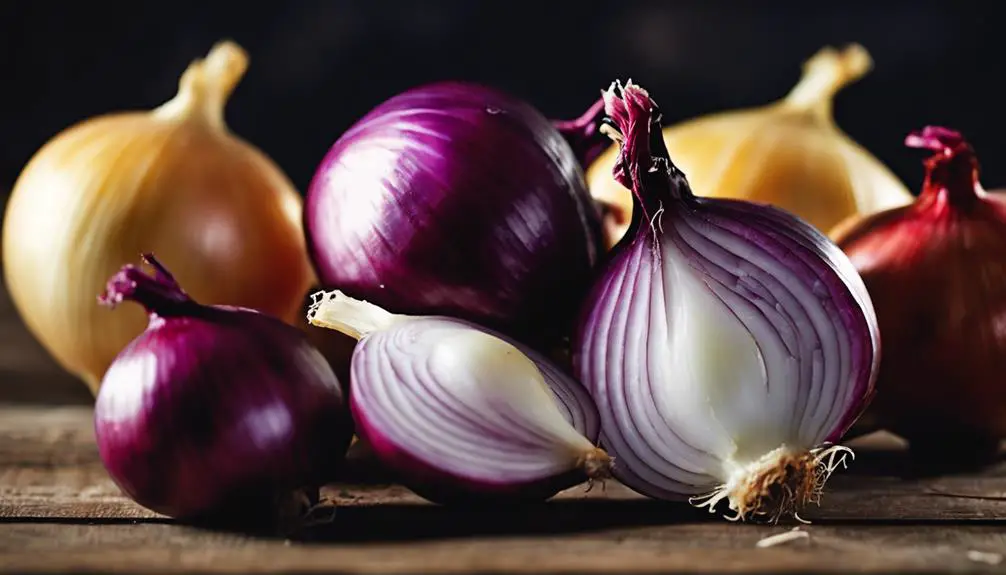
When it comes to vacuum sealing and freezing onions, selecting the right ones isn't just a simple task – it's an art form that requires careful observation and culinary intuition. Not all onions are created equal when it comes to long-term storage, so it's important to choose the freshest ones that hold the promise of flavor and longevity within their layers.
To start, look for onions with tight, dry outer skins. If you see any signs of moisture or soft spots, it's a clear indication that the onion may not withstand the freezing process. Give them a gentle squeeze to check for firmness. Onions that yield too much to pressure are likely to disappoint when it's time to use them from the freezer.
The color and appearance of the onions also speak volumes about their freshness. Aim for bright, vibrant colors and avoid onions that have started to dull or show signs of sprouting. These subtle cues will guide you in choosing onions that not only freeze well but also retain their flavor and texture, ensuring that your culinary creations are always top-notch, no matter when you decide to use them.
Preparing Onions for Freezing
When you have chosen the best onions, it's crucial to prepare them properly for freezing to preserve their flavors at their peak. The first step is peeling them. To make this easier, cut off the non-root end and make a small cut in the outer layer, allowing the skin to come off effortlessly. This reveals the true essence of the onion, ready for the next step.
After peeling, you can slice or chop the onions depending on how you plan to use them in the future. For soups and stews, chopping is ideal, while thinly sliced onions are perfect for sandwiches and salads. This step isn't just about preparation; it's also about the excitement of imagining the delicious dishes these onions will enhance.
Next, spread the onions out on a baking sheet, making sure they don't touch each other. This prevents them from freezing into a solid block, making it easier to use only the amount needed later on. Once they're partially frozen, gather these precious culinary gems and prepare them for their final destination: the vacuum sealer bag. This step is crucial because vacuum sealing locks in the freshness, ensuring that every dish they're used in will be as flavorful as if the onions were freshly picked from the garden.
Blanching: Is It Necessary?
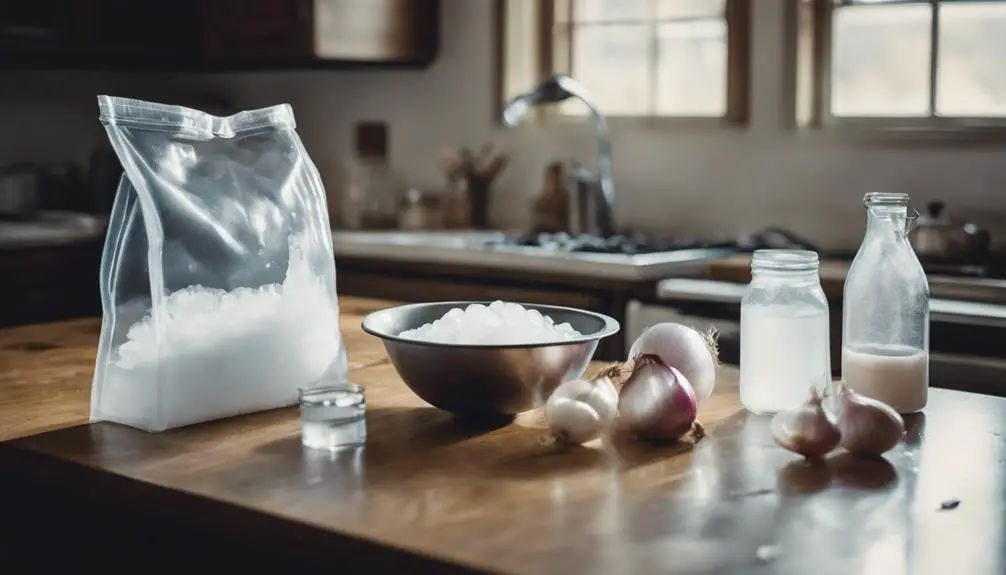
Is Blanching Necessary for Freezing Onions?
You may wonder if blanching your onions before freezing them is really necessary. Let me break down this process for you. Blanching involves briefly boiling your onions before freezing them, and it's a step that I highly recommend. Why? Because it stops the enzymes that can cause your onions to lose their flavor, color, and texture.
Imagine putting all that effort into freezing your onions, only to find them mushy and tasteless later on. That's exactly what blanching helps prevent. It acts as a safeguard, ensuring that your onions stay fresh and flavorful, just like when you first chopped them.
Additionally, blanching also helps clean the surface of your onions, getting rid of any dirt or microorganisms that may be present. It's an extra step, yes, but it significantly enhances the safety and quality of your frozen onions.
But don't just take my word for it; try it yourself. Once you see the vibrant color and taste the crisp, fresh flavor of your blanched, frozen onions, you'll understand why it's worth the few extra minutes. Blanching isn't just a suggestion; it's the key to preserving the true essence of your onions.
Cooling and Drying Onions
Cooling and Drying Onions
After blanching, it's important to cool your onions quickly to preserve their texture and flavor for freezing. This step is crucial in maintaining the freshness and essence of the onions. Here is my approach to this process:
To begin, plunge the blanched onions into a large bowl of ice water. This will immediately stop the cooking process and prevent them from becoming overcooked. Stir the onions occasionally in the ice bath to ensure even cooling. This step is essential for maintaining a uniform texture throughout.
Once the onions have been sufficiently cooled, drain them thoroughly using a colander. It's important to remove as much water as possible to prevent the formation of ice crystals during freezing. To further eliminate excess moisture, pat each onion piece gently with clean kitchen towels. This will help prevent freezer burn and maintain the quality of the onions.
After patting dry, allow the onions to air dry for a few moments on a clean kitchen towel. This will ensure that any remaining moisture evaporates, leaving the onions perfectly prepared for vacuum sealing and freezing.
Portioning for Future Use
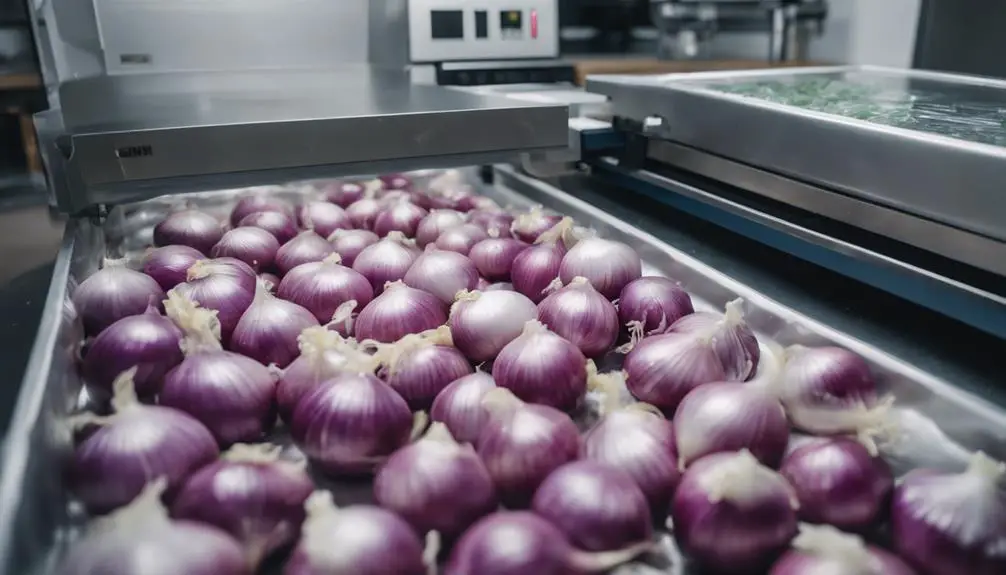
Before you start vacuum sealing your onions, it's important to divide them into portions that suit your cooking needs. This way, you'll have easy access to the right amount of onions for your recipes all year round. It's a simple step that can save you time and reduce waste, making meal prep a breeze. Just imagine being able to reach into your freezer and grab exactly the amount of onions you need, without any excess.
To determine the ideal portion sizes, consider the dishes you cook most often. For recipes like soups, stews, and stir-fries, you'll typically need about a cup of onions. So, it's a good idea to portion them accordingly. For dishes that require less onions, such as omelets or sandwiches, pack smaller quantities. To ensure accuracy, use a kitchen scale to measure out portions ranging from half a cup to a cup. This way, you won't end up thawing more onions than necessary, which can lead to waste.
To keep things organized, label each portion with the date and quantity. This makes it easy to rotate your stock and use the oldest onions first. It's an essential step for maintaining the quality and flavor of your onions. By taking the time to portion your onions now, you'll make cooking in the future effortless. And you can rest assured that each dish will be as fresh and flavorful as possible.
The Vacuum Sealing Process
Now that you've divided your onions into portions for your cooking needs, let's explore the vacuum sealing process. This step is crucial for locking in freshness and extending the shelf life of your onions in the freezer. By vacuum sealing them, you not only preserve their flavor but also prevent freezer burn, ensuring that your onions stay fresh and vibrant.
Here's how I approach the vacuum sealing process:
- Pre-chill: To prevent the onions from releasing juices during vacuum sealing, which can interfere with the seal, start by pre-chilling the portioned onions in the freezer.
- Prepare the bags: Choose high-quality vacuum seal bags and ensure there are no creases or moisture on the sealing edge. This is important to achieve a perfect seal.
- Fill the bags: Carefully place the pre-chilled onion portions into the bags, leaving enough space at the top for sealing.
- Vacuum and seal: Use a vacuum sealer to extract the air from the bag and seal it tightly. It's exhilarating to watch the bag shrink around the onions, effectively locking in their freshness.
- Final check: Inspect each bag for any possible air pockets and ensure a tight seal. This will ensure that the onions are ready to be stored in the freezer.
Proper Labeling Techniques
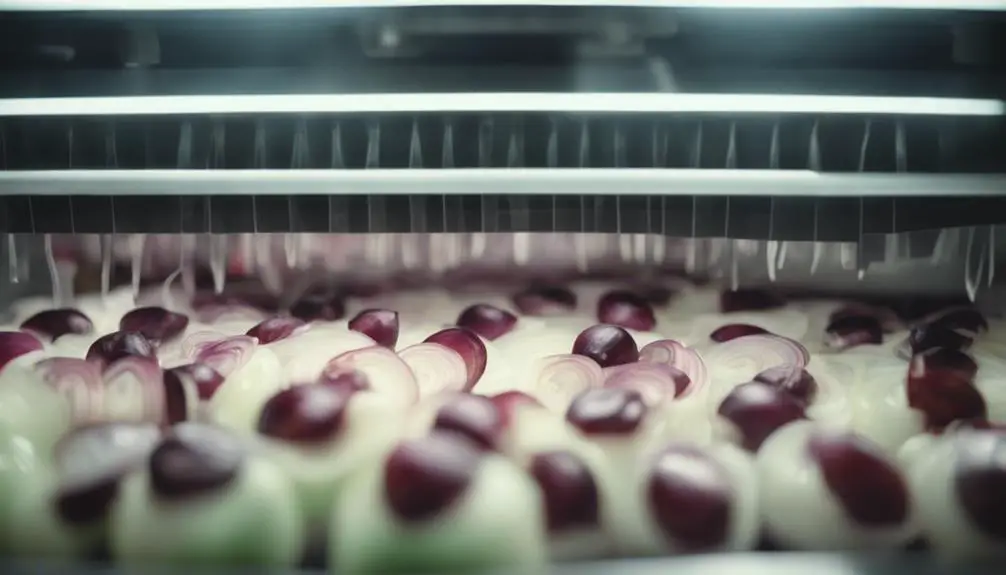
Labeling each vacuum-sealed bag of onions is a crucial step in preserving their freshness and ensuring they're ready for your next culinary adventure. Taking a moment to detail the contents and packaging date will pay dividends when you're rummaging through your freezer, looking for the perfect ingredient.
To label the bags, use a permanent marker and write directly on them. This ensures that the information withstands the cold and time. Here's a simple table you can follow to keep things organized:
| Date | Content | Quantity |
|---|---|---|
| 04/01/2023 | Yellow Onions | 2 cups |
| 04/01/2023 | Red Onions | 1.5 cups |
| 04/02/2023 | White Onions | 2.5 cups |
| 04/02/2023 | Sweet Onions | 2 cups |
| 04/03/2023 | Green Onions | 1 bunch |
This method not only helps you track when you sealed the onions but also allows you to quickly identify the type and amount without thawing or opening the bag. It's a simple yet effective system that ensures your onions remain an asset rather than a mystery in your kitchen.
Storing in the Freezer
When it comes to storing your vacuum-sealed bags of onions in the freezer, finding the perfect spot is crucial. This will ensure that their flavors are preserved and ready for your future culinary creations. It's not just a matter of tossing them in; strategic placement is key for maximizing freshness and accessibility.
Here are some tips to help you keep your onions in prime condition:
- Avoid the Door: The temperature in the door of the freezer can fluctuate too much, so it's best to choose a cooler and more stable spot elsewhere.
- Flat Lay: To save space and ensure even freezing, lay the bags of onions flat. Once they're frozen, you can stack them on top of each other.
- Separate from Sensitive Foods: Onions have a strong odor, so it's important to keep them away from foods like ice cream or butter that can easily absorb flavors.
- Use a Container: If you're freezing a large number of bags, consider placing them in a larger, airtight container. This will protect them from freezer burn and accidental punctures.
- Rotate Stock: To ensure that you use your onions in a timely manner, always use the oldest bags first. This simple practice of 'first in, first out' will help keep everything fresh.
Storing vacuum-sealed onions in the freezer isn't just about extending their shelf life; it's about ensuring that each dish you prepare is packed with flavor. Think of your freezer as a treasure chest of culinary potential. By following these tips, you can make the most of your frozen onions and enjoy delicious meals for months to come.
Frequently Asked Questions
Can Vacuum-Sealed and Frozen Onions Retain Their Texture and Flavor When Used in Raw Dishes After Thawing?
Vacuum-sealed and frozen onions may not maintain their crisp texture and strong flavor when used in raw dishes after thawing. They are better suited for cooked recipes, where these changes are less noticeable.
When it comes to raw dishes, such as salads or salsas, the texture and flavor of the ingredients play a crucial role. Fresh, crunchy onions can add a delightful bite to these dishes. However, when onions are vacuum-sealed and frozen, they tend to lose some of their crispness. The freezing process can cause the cell walls of the onion to break down, resulting in a softer texture.
Additionally, the flavor of the onions may become milder after thawing. Freezing can cause some of the volatile compounds responsible for the strong onion flavor to dissipate. As a result, the onions may not have the same potent taste as fresh ones.
To ensure the best results in raw dishes, it is recommended to use fresh onions whenever possible. However, if you only have frozen onions on hand, there are a few tricks you can try to improve their texture and flavor. One option is to lightly sauté or blanch the thawed onions before adding them to your dish. This can help revive some of the crispness and enhance the flavor.
Another option is to use frozen onions in dishes where the texture and flavor changes are not as noticeable. For example, they can be added to soups, stews, or cooked sauces, where the onions will blend in with other ingredients and their texture will be less noticeable.
If you prefer the convenience of having frozen onions on hand, you may want to consider purchasing pre-chopped frozen onions from reputable brands. These brands often use special freezing techniques to minimize texture and flavor changes. Look for products that specifically mention retaining texture and flavor on their packaging.
How Does the Process of Vacuum Sealing and Freezing Onions Affect Their Nutritional Content?
Vacuum sealing and freezing onions is a fantastic way to preserve their nutritional content. This method acts like a time capsule, locking in all the vitamins and minerals that make onions such a powerhouse of nutrients. By vacuum sealing and freezing them, you can ensure that these valuable nutrients are retained for future use.
When onions are vacuum sealed and frozen, their nutritional content remains intact. This means that you can enjoy the same health benefits from using frozen onions as you would from using fresh ones. Onions are rich in vitamin C, vitamin B6, and dietary fiber, among other nutrients. These nutrients are essential for maintaining a healthy immune system, supporting brain function, and promoting digestive health.
The process of vacuum sealing and freezing onions is simple and convenient. First, peel and chop the onions according to your preference. Then, place the chopped onions in a vacuum-sealed bag or container, making sure to remove as much air as possible. Finally, place the bag or container in the freezer and leave it until you're ready to use the onions.
One of the advantages of vacuum sealing and freezing onions is that it allows you to have a ready supply of onions on hand whenever you need them. This can be particularly beneficial if you use onions frequently in your cooking but don't always have fresh ones available. By having a stash of frozen onions, you can easily add them to soups, stews, stir-fries, and other dishes without worrying about them going bad.
Additionally, vacuum sealing and freezing onions can help you reduce food waste. Onions have a relatively short shelf life, and they can spoil quickly if not used in a timely manner. By freezing them, you can extend their lifespan and avoid wasting any unused portions.
When using frozen onions, it's important to note that they may have a slightly different texture compared to fresh ones. However, their flavor and nutritional content remain intact. You can use frozen onions in cooked dishes without thawing them first, making them a convenient and time-saving ingredient.
Are There Any Specific Types of Vacuum Sealers That Work Best for Sealing Onions, or Will Any Model Do?
Most vacuum sealers should work well for sealing onions, but models with adjustable vacuum settings are particularly beneficial. With adjustable settings, you have the ability to control the sealing pressure, which ensures that the onions are not crushed during the sealing process. This is important because it helps preserve the texture and flavor of the onions perfectly.
By being able to adjust the vacuum pressure, you can customize the sealing process to suit the delicate nature of onions. This means that you can apply just the right amount of pressure to remove excess air from the bag without causing any damage to the onions.
One vacuum sealer that comes highly recommended for sealing onions is the Foodsaver V4840 2-in-1 Vacuum Sealer Machine. This model offers adjustable vacuum settings and provides a secure seal without crushing the onions. It also has a built-in bag cutter and roll storage, making it convenient to use.
Another excellent option is the NutriChef Vacuum Sealer. This model also has adjustable vacuum settings and offers a gentle yet effective sealing process for onions. It is compact and easy to use, making it a great choice for home use.
Can I Vacuum Seal and Freeze Onions That Have Already Been Cooked, or Is This Method Only Suitable for Raw Onions?
Yes, you can vacuum seal and freeze cooked onions, not just raw ones. This method effectively preserves their delicious flavor and maintains their texture, providing a convenient way to store and use leftover onions later on.
By vacuum sealing the cooked onions, you are removing excess air from the packaging, which helps prevent freezer burn and maintains the quality of the onions. Freezer burn occurs when moisture evaporates from the food and forms ice crystals, resulting in a dry and unpleasant texture.
To vacuum seal cooked onions, first allow them to cool completely. Then, transfer the cooked onions into a vacuum-sealable bag or container. Make sure to spread them out in a single layer to ensure even freezing. Seal the bag or container using a vacuum sealer according to the manufacturer's instructions.
Label the package with the date and contents, and place it in the freezer. It's a good idea to freeze the cooked onions in portion sizes that you will use in one go. This way, you can easily thaw and use only what you need without having to defrost the entire batch.
When you're ready to use the frozen cooked onions, simply remove the desired portion from the freezer and thaw it in the refrigerator overnight. The onions will retain their flavor and texture, making them perfect for adding to soups, stews, stir-fries, or any other dish that calls for cooked onions.
Using vacuum-sealed and frozen cooked onions is a great way to minimize food waste and save time in the kitchen. It allows you to have pre-cooked onions on hand whenever you need them, making meal preparation quicker and more convenient.
How Do You Effectively Manage Strong Onion Odors When Vacuum Sealing, to Avoid Contaminating the Sealer and Other Foods in the Freezer?
When it comes to effectively managing strong onion odors while vacuum sealing, there are a few strategies you can employ to avoid contaminating the sealer and other foods in the freezer.
One effective method is to freeze the onions before vacuum sealing them. Freezing helps to reduce the release of odors, making it less likely for the smell to permeate the vacuum sealer or other foods. This step is especially important if you're dealing with particularly pungent onions.
Another crucial aspect is using a dedicated sealer for fragrant foods. This means having a separate vacuum sealer specifically designated for onions and other strong-smelling items. By doing so, you minimize the risk of cross-contamination and ensure that the odors won't transfer to other foods or linger in the sealer.
It's worth noting that not all vacuum sealers are created equal. Some models are designed with odor control features, such as built-in filters or specialized sealing mechanisms that help prevent the spread of odors. If you frequently vacuum seal onions or other fragrant foods, investing in a sealer with these features can be a wise choice.
In addition to these strategies, it's also important to store the vacuum-sealed onions properly in the freezer. Make sure they are placed in airtight containers or bags to further contain any remaining odors.
Conclusion
Vacuum sealing and freezing onions is a fantastic way to preserve their freshness for an extended period of time. By carefully selecting and preparing the onions before sealing them, you can capture their essence and preserve their pungent aroma and crisp flavor. It's like bottling up the taste of summer to enjoy during the colder months.
This method of preserving onions goes beyond just preserving food; it's an art form. By vacuum sealing the onions, you ensure that each one becomes a treasure chest of flavor, ready to enhance any culinary creation you embark on. Whether you're making a hearty stew, a savory soup, or a mouthwatering stir-fry, these frozen onions will infuse your dishes with the freshest and most vibrant flavors imaginable.
To get started, make sure you have a vacuum sealer and freezer-safe bags or containers. Begin by selecting the freshest onions available. Look for onions that are firm, with no signs of soft spots or mold. Peel and chop the onions according to your preference, whether it's finely diced or sliced into rings.
Now it's time to vacuum seal the onions. Place the chopped onions in a freezer-safe bag or container, leaving some space at the top. Using your vacuum sealer, carefully remove the air from the bag or container, creating a tight seal. This will prevent any air from getting in and causing freezer burn, which can affect the quality and taste of the onions.
Once the onions are vacuum-sealed, label the bags or containers with the date of freezing. This will help you keep track of how long the onions have been stored and ensure you use the oldest ones first. Place the sealed bags or containers in the freezer, making sure they're stored in a flat position to maximize space.
When it's time to use the frozen onions, simply remove the desired amount from the freezer and thaw them in the refrigerator overnight. You can also thaw them in a bowl of cold water if you're in a hurry. Once thawed, the onions can be used in any recipe that calls for fresh onions. They'll retain their flavor and texture, making them a convenient and tasty addition to your meals.
By vacuum sealing and freezing your onions, you can enjoy their fresh taste and aroma all year round. Say goodbye to wasted onions and hello to flavorful dishes that are sure to impress. Give this preservation method a try and elevate your culinary creations to new heights.
